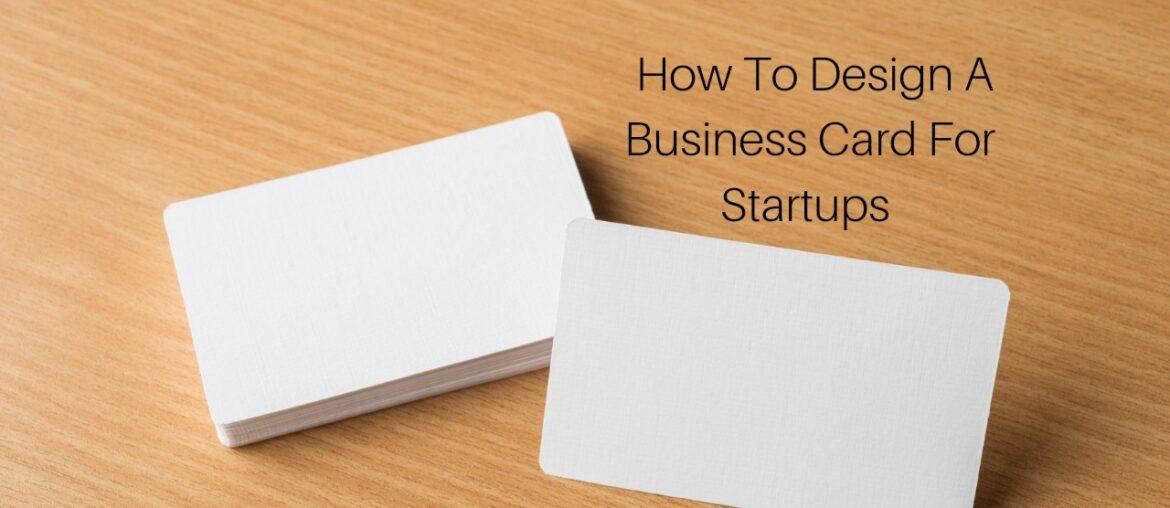I have encountered so many people asking me how to design a business card for startups and I promised to research and discuss it here. Read along with me.
If there is one thing that can’t be overestimated, it is the value of business cards. Many of the fundamental requirements of the professional are met by these commercial multi-tools, including advertising, brand awareness, calls to action, and, obviously, contact information.
If properly created, these small billboards can win over passing strangers and turn them into lifelong clients.
What is a Business Card
A business card is a tiny, printed paper card that is typically credit card size and contains information about your company, including your name, contact information, and brand logo.
Your business card design is an essential part of your branding because it is a visual representation of your brand identity.
Read- What entrepreneurs and startups struggle with most and solutions.
How To Design A Business Card For Startups
We will go over all you need to know about business card design as a startup in this article so you can give your designer detailed instructions. Business cards should always be personalised.
This guide explains your options for the card that is best for you and the 8 steps to creating a business card.
You are ready to begin once you have your logo, brand colours, and a clear understanding of what you want your business card to say about you.
To determine which business card design would work best for you, simply follow the 8 steps listed below:
- Select a shape
- Select you size
- Add your emblem and additional graphics
- Add the required text
- Choose a font styles
- Think about the unique finishes
- Choose a designer
- Complete the design
1. Select a shape
You can move on to the next stage if you’ve already chosen a conventional, rectangular business card. However, if you are interested in learning about all of your alternatives, including unconventional ideas, keep reading.
Professionals have more freedom to experiment with unconventional shapes as printing technology becomes more sophisticated and accessible. Die-cutting, a printing method, enables you to cut out any form while continuing to print in large quantities.
For a friendlier business card, you may just go around the corners on the more conservative end of the spectrum. However, if you truly want to be amusing or stick out, you can use almost any shape, including animal mascots, product outlines, or a unique shape.
Even your entire business card motif could be based on creative cutting. Depending on the impression you want to make, you might or might not use inventive shapes. Special shapes help you stand out and seem more entertaining, but they can backfire in more traditional sectors.
After completing step 6 and completing your design, you might wish to look again at the die-cutting option.
2. Select your size
The card’s size is the next choice you must make. This largely depends on the national norm, so that’s where you should start. Even if your goal is to stand apart, you must be aware of what everyone else is doing to do the opposite.
No matter the size, three things should always be taken into account when designing:
- Bleed Area: The area of the card that is most prone to be removed is its outermost portion.
- Trim line: The trim line is the line that should be used to cut cards.
- Safety line: Outside of the safety line, there is a risk of cutting errors. Don’t allow crucial components like text or logos to go outside of this area.
Setting the trim line at 0.125 in. (3 mm) from the edge is a good idea even though these areas differ depending on the size and printer.
The safety line should then be set at 0.125 in. (3 mm) from the trim line. The total distance from the edge of the bleed area to the interior of the safety area is 0.250 in (6 mm).
3. Add your emblem and additional graphics
The logo is the first graphic component of your business card design that we will lay out now. On your business card, your logo should be the main focus, while other flourishes and supplemental visuals can occasionally be effective as well.
Remember that you can use both sides of the coin. One tactic is to only include the logo on one side of the business card and display the recipient’s contact information on the other. However, it’s also advantageous to have the logo on both sides.
However, this is only one tactic among many. Feel free to try different logo placements until you find one that suits your preferences.
Although minimalist designs are common for business cards, you can add more visuals if the bare area doesn’t appeal to you. Any associated graphics serve the same purposes whether your logo is complex or just text.
Adding more graphics is a good way to showcase your business identity. You can convey your or your brand’s personality through images, including colours, without stating it out loud. For instance, a funny cartoon and some vibrant colours would look approachable or casual, respectively.
Another trend that is becoming more and more common is using a little mystery to pique people’s attention. Brands typically use a wordless image with a URL on one side and all the essential information (such as the name of the company and its employees) on the other.
4. Add the required text
What’s written on your business card is up to you. Freelancers that work from home may not require a postal address, whereas occupations that include in-person consultations do. Or perhaps you’re making a purposeful decision, like highlighting your huge social media following.
The idea is that various individuals can profit from utilising various content on their business cards.
Choosing what to include on your business card is the next stage, so do that now. You can choose which options to include and which to omit by looking at the list of popular options below.
- Name A given. Each card must have a name.
- Company name:?Another given, unless it pertains to personal branding in which case it is your name.
- Your job title: should be included on traditional cards. This serves to remind the recipient of your message about who you are, what you do, and even how you met.
- Phone number: Even if you don’t prefer it, some people prefer talking on the phone to other forms of communication.
- Email: A must-have for business cards, email has become the standard for non-urgent business communications, in part because it facilitates the attachment of documents.
- URL of your website: Including your website’s URL is a friendly invitation to visit.
- Social media: Include links to your social media accounts if they are pertinent to your field or if you simply want to display some of your personality.
- Address: Important for attracting clients to your office or retail space.
- QR code: While not as common as it once was, a QR code is still an effective shortcut for sending whatever data you require. Here are all the benefits of using a QR code.
- Slogan: Completely optional, a tagline aids in establishing business identity and lends some personality.
Keep in mind that the purpose of business cards isn’t merely to transmit information, but also to retain it. Even though they might already be aware of your phone number, address, or URL, keep a card on hand just in case.
5. Choose a font style.
You can select how it looks once you’ve decided what you want to say. Typography is crucial at all times, but on business cards, it’s more important because there isn’t much room and the text needs to be entirely readable.
Let’s divide typography into these three basic groups:
- Size: You want all of your text to be at least 8 points in size to preserve readability. However, feel free to experiment with different text sizes because you want your most crucial components, like your name, to stand out. Keep your text tiny enough that there is plenty of breathing area around each piece; you don’t want to overcrowd your card.
- Colour: A pre-existing brand’s colour scheme can be useful in this situation. Select text colours that complement your card’s backdrop colour, which should match your brand while being consistent with it. Try using contrasts to improve legibility since while similar colours may appear beautiful together, they can make text difficult to read.
- Font: The most important thing in typography is legibility; this is the golden rule. No matter how beautiful your font is, it won’t matter if no one can read what it says.
6. Think about unique finishes
As you near the finish line, it’s time to start thinking about printers, particularly in terms of what they can provide.
Some printers provide unique finishes that can help leave a lasting impression. Check to see if any of these “special effects” will help your design plan for business cards.
- Embossing: By using this process, three-dimensional reliefs are created, causing some regions to “jump out.” Similar to spot UV coating, you can use it to highlight particular elements of your card, including words.
- Letterpress: Letterpress printing pushes the paper down while inking it as opposed to lifting it. The result resembles an engraving and is frequently printed with distinctive ink to attract more attention. Useful for letters since it lends your words more gravity.
- Foil stamping: You can foil stamp the whole or just a portion of an image to create something glossy and reflecting like tin foil. If you’ve selected a bold enough typeface, this also works for underlining text.
- Spot UV coating: A smooth varnish is used on several cards to give them a gloss and smooth touch. The same procedure is done, but only in specific places, using spot UV treatment. This implies that you can only gloss a portion of your logo, a set of visuals, or even a single word or phrase. Use it to highlight specific parts over others, but keep in mind how it will change the composition overall if only a small portion is sparkling.
7. Choose a designer to finalize your design
Finding a skilled designer who can make the ideal card for you is a smart idea if you want to stand out with your business cards.
You can hunt for a local freelance designer or look for one with the proper aesthetic and experience on a website like 99designs. To determine if they are a suitable fit for your brand, be sure to look over their portfolio.
Once you have identified the ideal person, make an effort to explain your company’s mission and the type of atmosphere you want to create so your designer can realize your vision.
8. Complete the design
You can reevaluate your design to make sure everything functions after all the components are in place and an accurate projection of your final colour choices and special finishes is available.
Analyze the visual flow by watching how your eyes move when viewing the card.
- What do you first notice?
- What did you notice Last?
- A solid visual flow should begin with the logo
- Go on to the name
- Move on to the secondary information, and then, if applicable, end with any supplementary graphics. The size and placement of an element can always be altered to improve the visual flow.
Additionally, you should get rid of all the clutter you can. Is every piece of information required? The more the impact each has, the fewer the remaining components are.
Verify again to make sure you avoided any typical mistakes. Is the writing clear? Are the hues in conflict? Are there any parts that are too near the edge?
Don’t forget to request a vector file and a PDF that is based on vectors from your designer once the project is complete. In case you need to adjust the size, vector graphics are preferred, and nearly all printers can read PDF files.
Advanced Methods of Designing a Business Card for Startups
You only need to follow these eight steps to make a business card that works flawlessly, but if you want to go above and beyond, think about these more sophisticated suggestions:
- Make a splash with a brilliant concept
- Prevent borders
- Spend less on colours
1. Make a splash with a brilliant concept
You can use more innovative techniques for differentiating oneself if your sector permits some whimsy.
This could be something intricate or something thematic like :
- Scented inks
- doubling or tripling the card’s width to increase its thickness utilising different materials (metal, plastic, rubber, etc.)
- folded cards
- transparent cards
We’re seeing a lot of that last trend lately, and for good reason. A see-through card, like the card below, can be used for a variety of purposes.
2. Prevent borders
Although, in theory, borders are a good way to frame the information of your card, cutting errors are so common that borders do more harm than good.
It is important to plan with bleed and safety regions because it’s pretty much impossible to cut every single card correctly in a large order. Small cutting errors magnified by borders detract from the overall design.
Read- 20 incredibly useful things you don’t know Google maps could do.
3. Spend less on colours
Don’t compromise on quality or quantity if you’re on a tight budget. By choosing just one or two colours, you can save a significant amount of money.
The price increases as you add more colours, but a clever designer will know how to make one or two colours appear just as nice.
2 Critical Design Elements you Need to Finalize Before Designing a Business Card
Let’s first talk about the prerequisites you need to know before designing a business card.
Before you even start thinking about business cards, regardless of whether you’re a solo freelancer, the founder of a fledgling startup, or a member of an established company, there are two critical design elements you need to finalise are:
- Finalized branding colour scheme and
- Know Yourself
1. Finalized branding colour scheme
The two most crucial visual decisions for branding are logos and colour schemes.
These components will not only have a significant impact on the design of your business card, but they will also have an impact on other features like layout and identity.
Read- What is so hard about starting a business.
2. Know yourself
This is one more step that is necessary before moving on to the rest of the business card design process.
- You must be aware of your communication goals.
- What kind of brand are you, as a person or a company?
- What do you want your business card to convey visually as well as verbally?
Here is a short list of inquiries to ask yourself to ascertain your brand identity. This is also a subject deserving its own discussion, so if you want to delve deeper, feel free.
Thinking carefully about your brand will be beneficial when designing your business cards in the future, especially when it comes to showcasing your personality.
Conclusion
What is the contemporary coat of arms in designing business cards? Your business card had to serve as a representation of you and your brand in addition to serving as a means of communication.
You want your business card to both standout and present you in a positive light because some people receive cards every day.
When designing your business card, don’t skimp. Find a talented designer to make your concept a reality after taking your time to come up with the ideal design.





